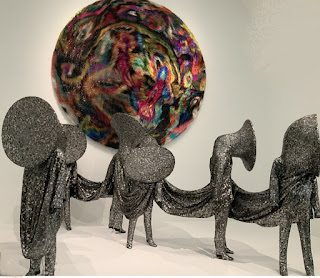Nick Cave is best known for his “Soundsuit” series, begun over thirty years ago. and now numbering over 500. With all its raukus, oversized, colorful variations, it is truly exuberant. More importantly for the artist’s standing in the contemporary artworld, it initiated a connection between his career and racial politics. Explanatory text tells us that the first Soundsuit was a gathering of sticks intended to conceal the artist’s racial and gender identity in response to the then recent beating of Rodney King. Within the racial justice wing of the contemporary artworld, that reaction is understandable since both King and Cave were young African American men in 1991. Outside that mindset, however, we might note that King could only find work as a part time laborer while Cave already had an MFA, a career in fashion, and a teaching position at a leading art school. King caught the attention of law enforcement because he was speeding, not because he was black. Then he led police on a high speed chase to avoid an alcohol test and possible suspension of his parole. Initially, all the officers involved were acquitted of using excessive force. In a second trial, two were convicted, but even then the presiding judge acknowledged that most of the beating was necessary to subdue the suspect. King’s status as a victim of racial injustice was questionable, but Cave presented it as clear cut. As he play-victimized himself, he simplified, personalized, and polarized a complex situation. As polarization in American politics has grown exponentially over the following decades, threatening the republic itself, we now might ask whether the artist really was acting responsibly even though he proclaimed himself “an artist with civic responsibility”
None of which can diminish the joyful visuality of these pieces, especially the wackiness and wonder of “Speak Louder” (2011) the most choreographed Soundsuit installation on display. Paradoxically, if any political message were intended it would appear to be cautionary. The seven sequin-suited humanoids are eyeless, earless, faceless, walking megaphones - presumably broadcasting “truth” at high volume. An appropriate metaphor for agit-prop art of all persuasions. One might also note that this piece is owned by two museums, the Chicago MCA and the Buffalo AKG. It doesn’t need to be on permanent display as the masterpieces of ABX painting often are. The intensity of an artist’s personal touch is not the issue. As with most of Cave’s work, fabrication was done by others. There’s a thrill in the surprise of first viewing - but beyond that, what’s left to see? Contrast that with Sam Gilliam’s “Cartouche” (1981), a painting now hanging on the museum’s lower level in memorial to his recent passing. One can never see enough of a good painting.
Accompanying “Speak Louder’ is one of Cave’s circular fabric tondo’s hung high up on the wall. It’s a colorful foil to the monochrome sound suits below - but it’s more decorative than expressive. His spectacular tondo’s shown at the Cultural Center in 2006 felt so much closer to an artist’s eye, hand, and spirit.
The rest of the exhibition is mostly in a darker tone. Cave delivers a message of racial grievance with his enshrinements of racist memorabilia. As quoted elsewhere, he’s been “on a crusade to find the most inflammatory, oppressive, despairing objects that I could find around the country.” And again, one might ask - is this really behaving responsibly? Even the museum of racist memorabilia in Michigan doesn’t show pieces this repulsive. Would Cave claim that these represent the majority opinion in any white community? Or is it only evidence of a fringe that may never go away ? As others presumably share his feelings of oppression and despair, what is supposed to be the positive outcome?
In many other pieces, Cave makes statements about black identity using bronze body casts taken from his own body parts. The artist happens to have a buff, heathy body - but body cast shapes express no inner spirit as carved or modeled figure sculpture can do. They retreat from surrounding space rather than seize and organize it. The resulting mood is grim, regardless of how uplifting the intended ideas may be. In contrast, Cave also uses plenty of mass produced, low end sculpture throughout the exhibit - kitschy toys, lawn decorations, and gift shop collectibles. The mood they create is often giddy because that’s what sells, and as we know, every true Chicago artist since Roger Brown is supposed to collect it. The one mood that Cave’s work does not engender is that of deep contemplation. It’s more like political cartoon.
The cloud of metallic spinners that fills the airspace of the atrium introduces this Nick Cave retrospective as if it were a kind of carnival. There is a sensory overload of flashing light and color. Like the rest of the exhibition, it includes both store-bought and bespoken artifacts. Many are fanciful eyecatchers, but a few take the shape of pistols - just to remind us, as the artist says, that violence is lurking right here in our own backyard. And isn’t that just like a carnival? The strange and alluring juxtaposition of the morbid and the glitzy - with just a hint of danger.
If Cave does not produce the kind of visual experience once associated with art museums, it’s not so much that the artist has fallen short as that the mainstream contemporary artworld has not called for it. A dazzling, politically correct (though not especially responsible) carnival of grievance is quite sufficient, thank you.




